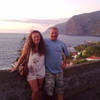Posted 10 years ago
 kivatinitz
kivatinitz
(344 items)
We bought this base to Dorita in 2008 for 10 U$. I began searching on the web to see what was it and I found one identical on http://www.glaskilian.de/Jugendstilvase-Rindskopf-s-Soe.107+B6YmFja1BJRD0xMDcmTD0xJnByb2R1Y3RJRD0xNzU0OCZwaWRfcHJvZHVjdD0xMDcmZGV0YWlsPQ__.0.html
Also, in the site of Alfredo Villanueva Collado http://users.skynet.be/fa000612/Rindskopf.htm there is much information about Rindskopf. For me it was a surprise that this vase was so old, I liked it immediately when I saw it, the green oily spots and the red ruby color, following the description of Alfredo clear glass furrowed in light green and shading to a wine red at the top. It has a sort of defect that is seen on the last picture.
I found the following data on http://www.pressglas-korrespondenz.de/aktuelles/pdf/pk-2004-3w-thistlewood-molineaux-rindskopf.pdf
Teplitz was a spa town of some repute (though not quite as grand as Karlsbad or Marienbad) and a fair number of glass factories developed in the surrounding area. In 1876 Josef Rindskopf was co-owner, with some of his brothers, of the glass company Brüder Rindskopf. The family, a large one, was descended from Josef Rindskopf's father, Beer (1799-1876). Almost all of the family members changed their name to Riethof a hundred or so years ago. In 1891, a year after his death, four of Josef Rindskopf's sons, Sidney, Albert, Edwin and Sherman (note their American/English names - Sherman was surely named after the American Civil War general) established a new company called Josef Rindskopf's Söhne A.G. (Josef Rindskopf's Sons) at Kosten. Soon after factories at Dux and Tischau (all near Teplitz) were added. Initially, at Dux, much of the output was coloured blanks that were sent to glass refineries in Haida (Nový Bor) to be finished off (decorated, etched, painted etc). Within a year or so, however, all Rindskopf's glass was finished off at their own factories. At Dux, new equipment was installed so that etching, painting, sandblasting and so on, could all be carried out on the spot. Iridescent Art Glass, as well as Crackle Glass and Frosted items ("eisglas") were made at Dux. At Tischau, iridescent Art Glass in the fashionable Art Nouveau style was also produced. Much of the output, as with many of the other Bohemian glass factories at the time, was for export.





























Thanks to all for loves, and for paris I decided not to post our original stuff because they do not get much loves. jaja
stunning!!!!!!!!!!!!!!!!!
Very nice!...:-)
Thanks again to all for the loves and the nice comments of Sean and inky
Great Information, I think that vase would match my bowl very well! Just Beautiful!